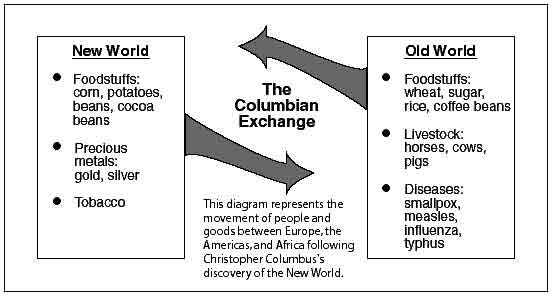
Source: The Columbian Exchange, globalimperialism, Wikispaces
Think back to elementary school in the cafeteria. Your lunch included a sandwich, a juice box, an apple and some fruit snacks. Your friend had a sandwich, a juice box, an orange, and some oatmeal cookies. You really want her orange; she really wants your apple. What do you do? You exchange them. The Columbian Exchange worked somewhat the same way. Explorers from the Old World (primarily Europe) would bring goods with them on their voyages to the New World (North and South America). Some of what they brought, such as coffee beans and pigs, did not exist in the New World.
Conversely, the explorers found crops such as potatoes, maize, and chiles that did not exist in Europe. The explorers traded for, and sometimes stole, these new goods to bring back home. In exchange, they left behind their unique items.
Both societies gained new plants, animals, foodstuffs, and inadvertently, diseases. See the diagram below for an example of some of the items that became part of the Columbian Exchange.

Source: The Columbian Exchange, globalimperialism, Wikispaces
Why did this exchange happen? The same reasons yours did back in the grade school cafeteria. Someone had something you wanted, or they saw value in something that you had, so you traded. Keep in mind though, not everything that was traded was a good thing. The diseases that the Europeans brought to the New World killed millions of the natives they encountered. Imagine how you would feel as a native person in the New World, when all of these new things are entering into your world. How would it feel to watch your world change before your eyes? Write about your ideas in your notes.
Click on the link below if you feel that you need more information about the Columbian Exchange.